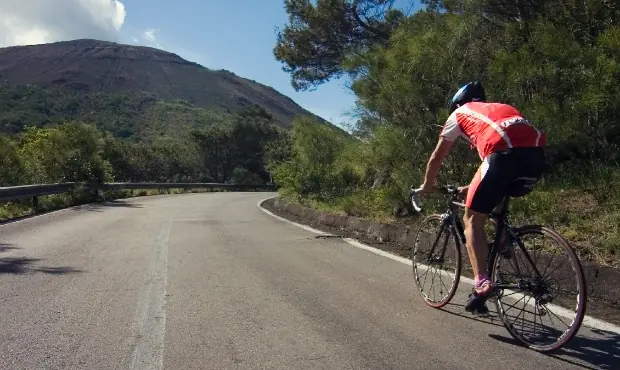
Your eyes burn from the sweat dripping down your brow. Your heart pounds and your breath feels shallow and pointless. You're pedaling hard but hardly moving. Tackling a mountain summit is one of the toughest challenges you'll face on a bicycle. But, with a little practice and a lot of strategy, we can give you the tools you'll need to accomplish this daunting feat.
From pedaling technique to meditation, use these six tips to help you reach the top.
Cycling Events Near You
#1 Build Your Functional Threshold Power (FTP)
If you wish to get better at climbing, particularly climbs that last 60 minutes or more, you'll need to train for it. The best way to do this is by improving your functional threshold power (FTP), which is the amount of power you can sustain for a one-hour period.
If you use a power meter to train, get your FTP by taking your average wattage over a 20-minute interval (as hard as you can ride), and multiply this number by 0.95. If you don't train with power, you can use your average heart rate to set training zones, but it won't be as accurate.
The workout: To build your FTP, do this classic interval:
- Warm up for 20 minutes.
- Do two 20-minute efforts at your FTP, with five minutes of easy spinning between sets. Your effort should be an eight or nine on the pain scale.
- Cool down for 15 to 20 minutes of easy spinning.
#2 Pace Yourself
Riding too hard at the bottom of a long climb almost always leads to disaster at the top. If you're using a heart rate monitor or power meter, watch it to keep a steady, even effort from the bottom of the climb all the way to the top. Staying within the proper zones is an easy way to keep from going too hard too early.
If you notice your numbers begin to spike, it's best to back off on the lower part of the climb even if you're feeling good. You can always speed up later when you're closer to the summit.
#3 Meditate
We've all seen cyclists in the Tour de France grimace and clench their teeth as they crawl to the summit of an epic climb. While that suffering and drama works great for a television audience, the best way for you to make it to the top is to keep your mind and body calm and relaxed.
Use these tips when you feel your muscles tense as you begin to dig deep into a world of cycling torture:
- Don't think about the pain: Look at the scenery, stare at the clouds or think about some far off peaceful place—whatever it is, just keep your mind preoccupied and don't focus on how bad your legs feel, or how far you've got to go before you reach the top. It's easier said than done, but focusing on the pain will inevitably make you slow down or stop altogether.
- Relax your body: Tensing the muscles in your face, shoulders and arms will spend energy you should be conserving. Relax your breathing as you concentrate on keeping the muscles in your face and upper body in a meditative state.
- Let go of the death grip: That tight grasp on the handlebars will make it impossible for your upper body to relax and could affect your pedaling motion. Instead, rest your hands lightly on the tops—keep your upper body still—and let your legs do a majority of the work.
#4 Concentrate on Your Technique
When your legs begin to tire, your pedaling technique will be the first to go. Use these tips to continue a consistent cadence and keep your legs as fresh as possible:
- Try to keep your revolutions per minute (rpm) around 90.
- Use compact chainrings (53/39) if you can't maintain a 90-rpm cadence with your current setup.
- Recruit power from your hamstrings, glutes, back and core by dropping your heel at the bottom of the pedal stroke and sliding back on the saddle.
- Sit up with your hands relaxed on the tops or hoods, which will open up your lungs and help you generate more power on steeper gradients.
#5 Stay Seated, Except?
Keeping your posterior in the saddle is the best way to conserve energy and recruit power from the most muscle groups. The one exception to this rule is on the sections of road with the steepest gradient.
Standing out of the saddle on these sections will help you generate more power for shorter durations and even out the muscle strain across your body. If there are multiple steep sections you have to navigate, try alternating sitting and standing to mix things up.
#6 Eat
Waiting too long to begin eating is one sure-fire way to crack before you reach the top of a long climb. Instead of waiting until you've completely depleted your energy stores, start eating during the first hour of your ride. Aim for 60g of carbs and at least one bottle of water per hour of cycling. While you're on the climb, stick to energy gels instead of energy bars or other food that's harder to digest during extreme efforts. Save those goodies for the break you've promised yourself once you reach the summit and before you head back down—which is where the real fun begins.
Related Articles:
 Ready to Ride? Search for a cycling event.
Ready to Ride? Search for a cycling event.
